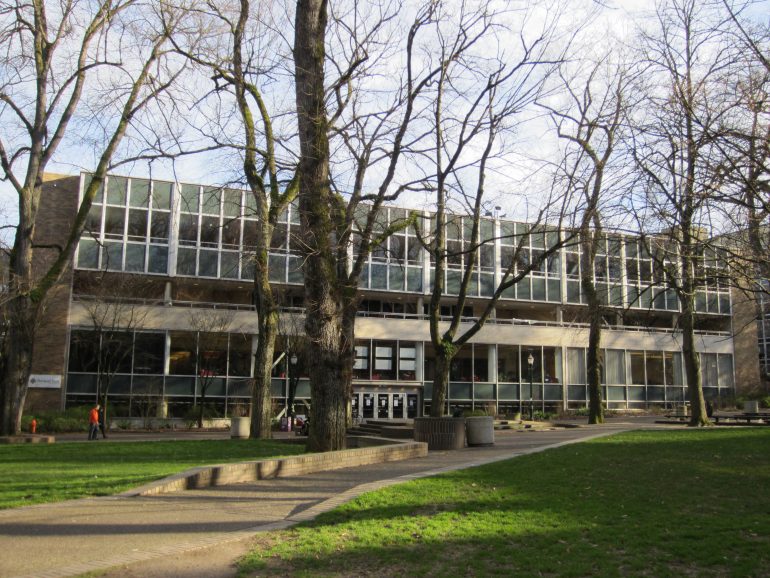Portland State University (PSU) is in the process of approving what will be the first Indigenous Studies major in Oregon. The proposal for the Indigenous Nations and Native American Studies (INNAS) Major has already moved through the College of Liberal Arts and Sciences and, if approved by the Faculty Senate and Provost, will be available for students at PSU beginning Fall 2018.
The major will expand the Indigenous Nations Studies (INST) program, which currently offers a minor. The proposal describes the INNAS Major as “a concentrated, decolonized study of Indigenous epistemologies and their value within a variety of contemporary contexts,” which explores themes including tribal governance and sovereignty, decolonization, sustainability, traditional and cultural ecological knowledge, and Indigenous science. Core courses will include “Intro to Native American Studies,” “Indigenous Women Leadership,” “Contemporary Issues in Indian Country,” “Indigenous Ways of Knowing,” and “Decolonizing Methodologies.”
During the 2016 calendar year, the INST program had 56 registered minor students, with similar numbers in previous years. Within the minor, approximately half of the students identify as Native and half identify as non-Native (primarily white). Social Science, Liberal Studies, History, English, and Anthropology are the most common majors accompanying the INST minor.
“We’ve looked at [the proposed major] from two different perspectives. It’s not just a focus in Native American Studies, and it’s not just a focus in Global Indigenous Studies, but kind of the bridging of both,” said Josh Powell, program coordinator of Indigenous Nations Studies. Powell provides administrative support to the unit, including budgeting and course scheduling, while splitting his time between INS and the School of Gender, Race and Nations.
The major has been a long time coming. “Our students have been asking for it for quite a number of years, and in some terms we have enough courses out that we can almost justify having the major as it is,” Powell said. Dean Marrongelle of the College of Liberal Arts & Sciences and the Provost even encouraged a proposal, but Powell describes the largest obstacle being logistical. “Even though there was some momentum on campus… to get something like this into place, we structurally didn’t have the capacity to do so.”
The INST unit, while often praised during talks of diversity in the university, was always hopeful to see that support continued in other areas. It could feel forgotten at times, Powell acknowledged, when up against university capacity in funding and faculty, but he thinks some of that support has finally materialized.
A turning point came when Cornel Pewewardy, Professor and Director of Indigenous Nations Studies, announced his retirement earlier this year. “A bunch of us got together and said, ‘How can we get this to come together?’”Powell said. Staff, faculty, and students all contributed to what he describes as a community effort over the summer to create a proposal that was unique and representative of the program. “In recognizing that Cornell had worked really hard to make it happen all these years, and with him exiting, we wanted it to come to fruition.”
Pewewardy is hoping to return as a Professor Emeritus, but his leadership and influence as Director was clearly significant and influential. With the Major on the horizon, Powell hopes the INST department can, “attract someone as strong a leader as Cornell to step into that role and help us navigate these new waters.”
The INNAS Major will be a first among Oregon universities. This August, Governor Kate Brown signed Senate Bill 13, which required the Department of Education to develop K-12 curriculum about the Native American experience in Oregon. However, beyond additional minor programs at University of Oregon, Southern Oregon University, and Eastern Oregon University, there is little curriculum for students looking to continue such studies as they pursue a higher education in Oregon.
“I feel [INNAS] would be an invaluable major that would be very important to a large number of students,” said Dressel. “Similar degrees are offered in colleges and institutions across Canada. Many of my classmates would have pursued the major if it were an option.”
This presents an educational vacuum that the INNAS Major hopes to fill. Portland is home to the ninth largest urban population of Native Americans in the United States, with a community of an estimated 58,135 individuals. The growth of the INST program aims to better serve that population and expand the related educational opportunities for Native and Non-Native students alike.
“One of the things that makes our unit unique, is that it gives this community a home inside the Portland Metro area that allows them to feel at comfort, much the same way the Native American Student and Community Center does. Our program acts as a home to students, but an intellectual one,” said Powell, “where they can feel that their traditional knowledge bases are honored, respected and expanded upon.”
“[INST] has allowed me to be me,” said Matthew Morsman, a member of the Confederated Tribes of Siletz Indians and coordinator for PSU’s United Indigenous Students in Higher Education organization. “The ability to network with other students, to address the true history of the United States and contemporary issues… Being able to hear everyone’s story that I have had class with, I feel their emotions as I can relate.”
Departments such as the INST serve an important role nationwide, bringing knowledge and culture that has been structurally marginalized back into what is considered “traditional” academia. Powell noted the wide-reaching effect of colonization worldwide and the enduring barriers that prevent the resurgence of Native American Indigenous knowledge.
“It’s looking at a way of not only decolonizing our education, but re-indigenizing it a bit,” Powell said. “Recognizing that although this knowledge base has been excluded, structurally, for some time, the knowledge base doesn’t cease to exist.”
The value of Indigenous Studies programs therefore lies in recognizing that Indigenous knowledge bases can coexist with traditional academic knowledge bases: for example, the experience of tribes that have worked with Oregon forests for thousands of years can supplement the scientific base of ecology, and vice versa.
“As an Environmental Studies major, I feel that the Indigenous Nation Studies minor program has added another dimension to my degree that makes me feel more connected to the environment than any science classes I have ever taken,” said INST minor Serena Dressel. “The coursework contains a variety of topics that help students to better connect to place while learning more about the history of the land that we occupy today.”
The integration of varying knowledge bases, however, does not commonly see the support it has at PSU . The effort to create an Ethnic Studies concentration at Harvard has a four decade history and is still ongoing. Other universities have seen Ethnic Studies programs that are often poorly supported to begin with be cut back or consolidated— the University of Wisconsin saw a heated debate over the consolidation of its Ethnic Studies program in 2014. A University of Wisconsin Badger-Herald article at the time interviewed Afro-American Studies professor Michael Thornton who said, “Ethnic studies are in crisis, and departments have vanished in past years… It is not a new trend on campus and is only driven by a desire to save money.”
Powell did not reflect similar concerns of consolidation when discussing PSU’s recently established School of Gender, Race, and Nations, which combines four separate programs into a single school.
“I think from the time that school was formed, there was a recognition that there was an equity issue, in the sense that we had two full-fledged departments, [Black Studies and Women, Gender, and Sexuality Studies], and then two programs [Indigenous Nations Studies and Chicano-Latino Studies] that don’t have that… So when they brought the four units together, it was with the expectation that all four units would eventually become a full program,” Powell said.
Powell spoke hopefully about using the experience from the INNAS proposal process to help the Chicano-Latino studies program make a similar growth in the future. The School of Gender, Race, and Nations is itself in the process of developing a proposed Master’s program. Powell sees that as a unifying prospect, with units such as INST serving as a building block for the success of the Master’s program. Powell envisions it building a foundation, “that the Master’s program is able to take and form to serve an even larger and broader community than if we were all separate… I think we’re all tied together for a single, unified vision of what this school can become.”
This article originally appeared in the print edition of our December 2017, issue.





